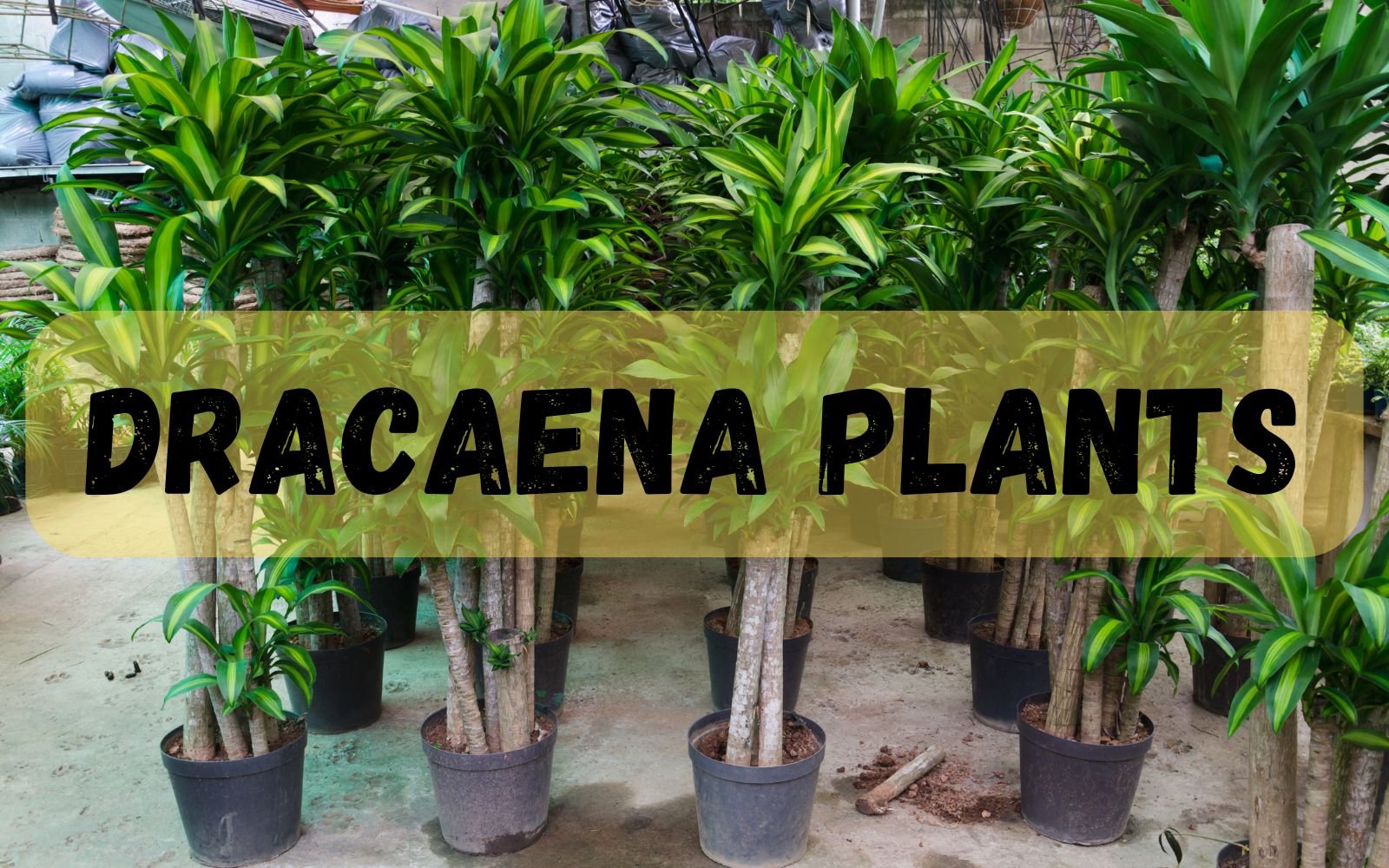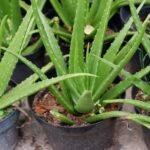Dracaena is a group of tropical plants originating from Asia, Africa, and Australia. They are also popular as home plants as they perform well in various conditions. Especially in low light, drought, and humidity. In this blog, we will explore the different types of dracaena plants, care tips, and common problems. Whether you are looking to add some greenery to your space or are seeking tips on how to properly maintain your dracaena, this guide has got you covered.
Table of Contents
ToggleTypes Of Dracaena Plants
People love these plants for their versatility, beauty, and ease of care. From easy options to unique, ornamental types, there’s a Dracaena for every space and style. Here are some popular types to consider:
Striped Dracaena (Dracaena Deremensis ‘Warnecki Ulysses’): This is a beginner-friendly plant with dark green, white-striped leaves that grow on sturdy stems.
Dragon Tree (Dracaena Marginata): Easy to care for, this plant has tall, thin stems topped with long green leaves with a reddish tint.
Cornstalk Dracaena (Dracaena Fragrans): A hardy variety with thick stems and broad, bright green leaves that thrives in a variety of conditions.
Lucky Bamboo (Dracaena Sanderiana), also known as ribbon dracaena, is a popular plant known for its unique curved stems, which take shape by adjusting to the direction of sunlight. It can stay small, just a few inches tall, or grow several feet tall. The ‘Variegata’ cultivar stands out with its bright yellow and green leaves.
Mass Cane (Dracaena Fragrans ‘Massangena’): A low-maintenance indoor plant with cane-like branches and yellow-striped green leaves.
Does A Dracaena Plant Flower?
These plants are popular houseplants. They have attractive foliage. Some varieties can also flower. Here’s a look at two flowering Dracaena species: the Corn Plant (Dracaena fragrans) and Dracaena massangeana. Also, tips to encourage their blooms.
Corn Plant (Dracaena fragrans)
- Native to Africa, it is also called the Cornstalk Dracaena.
- Popular houseplants have glossy leaves resembling corn leaves.
- Mature plants may produce fragrant white flowers. They smell of jasmine, lilac, and fresh grass.
- To encourage blooms, provide balanced light, stable temperatures, and high-phosphorus fertilizer.
Dracaena Massangeana
- Known as the happy plant.
- Flowering takes time, so be patient.
- Ensure good care and consistent watering to promote blooms.
With care and patience, Dracaena plants can bloom. Their fragrant flowers will enhance their beauty.
Grow and Care
These plants are not very difficult to grow, but the basic needs have to be met. Let us check out the right methods to help you grow your plant and care for them in the best way.
Light
These plants are adaptable to a variety of light conditions. They can grow in low light, such as in an office, or in bright light, such as near a sunny window. Varieties with bright colors thrive best in bright light. If planted outside, they prefer partial sunlight, as full sunlight can burn their leaves.
Soil and Water
Dracaenas need well-draining soil. Water the plant when the top soil feels dry, but do not let it dry out completely, as this can cause the tips of the leaves to turn brown. Avoid overwatering, as wet soil can harm the plant.
Temperature and Humidity
Dracaenas grow best in temperatures between 60°F and 75°F. Some varieties can tolerate temperatures up to 90°F in shade or 50°F in sheltered locations. They prefer humidity levels of around 60%, but they are fine with normal indoor humidity. If the air is too dry, using a humidifier can help.
Fertilizer
Feed your dracaena once or twice a year with a general-purpose houseplant fertilizer. Follow the instructions on the package for best results.
Pruning
These plants can grow from 2 to 10 feet tall, so you may need to trim them to keep their size manageable. Use a clean pruner or sharp knife to cut the stalks to your desired height during the growing season.
Pruning and Repotting
Proper pruning and repotting keep these plants healthy. Use these tips to ensure your plant thrives. Here’s what you need to know about pruning and repotting Dracaena plants.
Pruning
- The best time to prune is spring, when the plant grows rapidly, but you can prune at any time.
- Use a clean pruner or a sharp knife to cut the stalks to the desired height.
- Remove damaged stems, brown leaves or weak growth.
- To prevent infection, dip your tools in a solution of bleach and water before cutting.
Repotting
- Dracaena plants do not need to be repotted frequently, usually every 2-3 years.
- Choose a pot that is 1-2 inches larger than the existing pot.
- Avoid covering the root zone (where the roots meet the stem) with soil.
- Replace as much of the old soil as possible to freshen up the plant’s growing environment.
Benefits Of Dracaena Plant
Dracaena are the real beauties. These also come with lots of benefits. These can enhance your home or office and your health. Let us come to know how this plant improves our homes. It makes them healthier and more pleasant.
Improves Air Quality
Dracaena is an incredible air purifier. This should occur in homes where there are pollutants. Indoor air may trap harmful toxins. These include benzene, formaldehyde, trichloroethylene, and carbon dioxide. These come from daily activities, cleaning products, and synthetic ingredients. The Dracaena plant actively filters out these toxins, ensuring clean and fresh air. It helps reduce common health problems like allergies, respiratory problems, and headaches. It also makes indoor spaces more productive and enjoyable.
Enhances Humidity
Living in a dry climate or using air conditioning often can lead to low indoor humidity. Dracaena plants help by releasing moisture into the air. This raises humidity levels. This added moisture can work wonders for your skin, preventing dryness and irritation. It also helps with sinus pain and reduces breathing issues. This is important in cold seasons when indoor air gets very dry.
Reduces Stress
The lush, green leaves of a Dracaena plant are soothing. Research shows its vibrant, calming presence reduces stress and anxiety. Having plants like Dracaena can lower blood pressure. They can also boost mood and relax you. In workspaces, it boosts focus, creativity, and productivity. It does this by creating calm amid the hustle and bustle. People feel more at peace in green spaces.
Low Maintenance
One striking feature of Dracaena is its resilience and low-maintenance nature. This hardy plant thrives on little care. It is perfect for busy people and those who are new to plant care. Whether you forget to water it or don’t have time to cut it back, dracaena thrives. It brings greenery without much effort.
Aesthetic Appeal
People know these plants for their striking, architectural beauty. They add a sophisticated touch with their tall stems and lush foliage. With many shapes, sizes, and colors, they can fit any design. This includes modern minimalist and bohemian chic styles. The Dracaena enhances any space, be it a living room, office, or garden. It makes the area more vibrant and inviting.
Pet-Friendly Alternative
For those with pets, dracaena has a solution. Some varieties, like Dracaena fragrans, are nontoxic. However, as a responsible pet owner, beware. Some species produce a poisoning effect on animals if ingested. Sometimes the right variety or planting the right location can enable you to reap the benefits of the plant. At the same time, it will keep your pets safe.
More than just a pretty face, Dracaena plants clean the air, elevate your mood, and require very little maintenance. They are the perfect blend of beauty and practicality. If you want a healthier home, greater productivity, or some greenery, choose Dracaena. It is suitable for any lifestyle.
Common Dracaena Problems and Solutions
These plants are beautiful and easy to care for, but they can suffer from some common problems that affect their health. Here’s a guide to help you address some of the most common issues and solutions for Dracaena Plants.
Brown Leaf Tips:
Cause: High mineral content in tap water.
Solution: Use filtered or distilled water to stop tip browning.
Yellow Leaves:
Causes: Overwatering, poor drainage, or too much direct sunlight.
Solution: Allow the soil to dry out between watering, check for proper pot drainage, and keep the plant in bright, indirect light.
Wilted Leaves:
Cause: Underwatering.
Solution: Water the plant well, making sure moisture reaches the entire root system.
Leaf Drop:
Cause: Sudden temperature changes, drafts, or inconsistent watering.
Solution: Maintain a constant temperature, keep the plant away from vents or drafts, and adjust watering as needed.
Brown Spots On Leaves:
Cause: Fungal disease, often caused by excessive moisture or overwatering.
Solution: Remove affected leaves, improve air circulation, and reduce overwatering.
By adjusting watering habits, providing proper lighting, and monitoring conditions, most dracaena problems can be solved. Using filtered water also helps prevent common problems like brown tips.
Common Pests And Diseases
Dracaena plants are low-maintenance. But, they can get pests and diseases. Know the common issues and how to fix them. This will help keep your plant healthy and thriving. Here’s a quick guide to the most frequent problems and their solutions.
Mealybugs: White, cotton-like insects hiding in the joints of leaves. Remove them with a cotton ball dipped in water or rubbing alcohol.
Spider Mites: Tiny insects causing leaves to become discolored and curl. Look for webs or dots on leaves. Treat with insecticidal soap or neem oil and add moisture.
Fungus Gnats: Tiny insects that harm soil quality. Use soil without compost or bark, let the soil dry out, or use yellow sticky cards or beneficial nematodes to control them.
Scale Insects: These oval insects look like bumps and cause yellow leaves and stunted growth.
Aphids: Green or black insects that turn leaves yellow and leave a sticky residue. Wash off with soapy water or use insecticidal soap.
Thrips: Slender insects that cause silvery streaks and distorted growth. Treat with neem oil or insecticidal soap.
Propagating Dracaena Plants
These plants are easy to propagate. You can use stem cuttings, seeds, or crown cuttings. Each technique is simple. With care and patience, it can help you grow new plants. Here’s how:
Stem Cuttings : For stem cuttings, cut a 2–3 inch piece of the stem with at least two nodes, remove any leaves or flowers, and optionally apply rooting hormone to help it root faster. Lay the stem on top of a rooting medium.
Seeds: To propagate from seeds, rub the seeds between sandpaper to scarify them, soak them in warm water for 24 hours, then drain and plant them on moist, well-drained soil. Cover the seeds lightly with soil, and maintain a temperature of 25°C for germination.
Crown Cuttings: Crown cuttings involve cutting the top of the plant below the bunch of leaves, ensuring you include at least one node. Place the cutting in water in a warm spot, and roots should develop quickly.
Conclusion
In conclusion, Dracaena plants are easy to care for and can thrive in various indoor conditions. By learning about the different types and understanding how to look after them, you will be able to enjoy their beauty in your home. Whether you are dealing with common issues, pruning or repotting, taking simple steps to help meet their needs will help grow these plants out well.
FAQs
Is Dracaena Good for Home?
The easy-to-care air-purifying plant thrives in indirect light and boosts spaces with tropical richness. It is perfect for the home or office, growing slowly and needing less upkeep, and ideal for adding a pop of color.
Is the Dracaena Plant Good Luck?
Fortune or corn plants, known as indoor plants, bring good luck. Therefore, across Asian countries, the corn plant is noted to bring luck.
Does Dracaena Need Full Sun?
The Dracaena plant chooses indirect and bright light. This indicates that they should be placed near the window receiving the bright filtered light. Direct sunlight often scorches the leaves, leading to damage.







